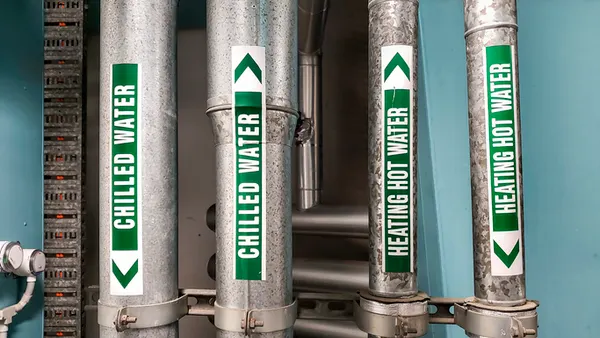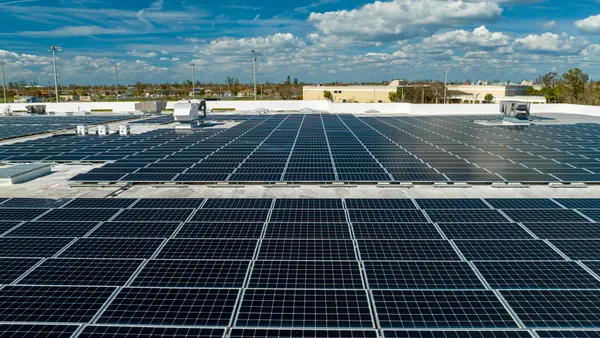In 2020, the way utilities charge customers and the business models they use could change electricity users’ role in the energy transition and support the enhanced adoption of new technologies.
Only about 6% of U.S. electricity customers now pay through rates that give them a role in the types of energy they use and when they use it. The rest use a rate that discourages customer interest, encourages no change in the power mix and gives utilities no motive to evolve, according to advocates for more dynamic rates. But 2020 promises major advances by state regulators in rate design and power provider incentives.
Efforts by state regulators and legislators in 2020 will show "the power of the states over the future of the electricity system in the absence of federal action," Energy Innovation (EI) Director of Electricity Policy Michael O’Boyle told Utility Dive. "States can and will move on their own and they are creating a framework and a foundation for change."
Utilities can now use new technologies, like smart meters and solar+storage, and new power system dynamics, like the shifting time of peak energy demand, to benefit their customers and their systems. In 2020, advanced rates with price signals to direct electricity use and business model reforms to align customer and provider needs could begin delivering big benefits. But one of 2020's biggest steps forward, to be taken by California, may be a misstep, a leading rate design authority said.
Complexity versus simplicity in 2020
In Q3 2019, "28 states plus D.C. took actions to reform rate designs, regulatory structures or utility business models," the newest quarterly policy update from the North Carolina Clean Energy Technology Center (NCCETC) reported. Rate design reforms were considered in 21 states and utility business model or ratemaking adjustments were undertaken in D.C. and 22 states.
Decisions and implementations of time of use (TOU) and other time-varying rates, including critical peak pricing, peak time rebates, and demand charges, and of simple subscription rates are coming in 2020, NCCETC Senior Policy Research Manager and quarterly lead author Autumn Proudlove told Utility Dive. These rates’ price signals discourage customer electricity usage during peak demand periods.
Critical peak pricing imposes significantly higher prices during critically high demand events, when system costs are highest or when the power grid is severely stressed. Demand charges add an extra cost to the monthly bill based on the customer’s single highest period of electricity consumption. And peak time rebates reward customers for load reductions during forecast critical periods.
"Providing more customer-friendly [rate] options also increases a utility’s ability to address the complexities in an electricity system with more renewables, more extreme weather events, and more customer-owned resources."

Lon Huber
VP for Rate Design and Strategic Solutions, Duke Energy
With subscription agreements, tiered price contracts would be based on the amount of monthly consumption and the amount of peak consumption. Customers could save money by choosing lower consumption. And electricity providers' greater load certainty would allow them to more cost-effectively and reliably manage their systems.
In 2020, debates will continue on how to balance complexity and simplicity in rate designs, but regulators' inclinations will begin to be clarified, Proudlove said.
Subscription pricing proposals may be decided in Arizona, Nevada, and Vermont in the coming year, according to NCCETC. Proposed pilots of more complex time varying rates will likely be ruled on for the Hawaiian Electric Companies (HECO) and Michigan’s DTE Energy.
This movement toward more advanced rate designs has largely been limited simply to TOU rates with more than the typical on-peak and off-peak time periods, Proudlove said. Newer ones, expected to see regulatory rulings in 2020, include critical peak periods or peak time rebates.
Hawaii’s Advanced Rate Design Strategy includes "time-varying rates, critical peak incentives, multi-part time-varying rates, and electric vehicle rates," NCCETC reported. Michigan’s Advanced Customer Pricing pilot includes "two time-varying rates, two demand rates, and two rates combining time-varying and demand elements." A National Grid pilot in New York includes both a TOU rate and a subscription rate.
These multi-faceted rate designs reflect an increased demand from customers for options, Duke Energy VP for Rate Design and Strategic Solutions Lon Huber told Utility Dive. "Providing more customer-friendly options also increases a utility’s ability to address the complexities in an electricity system with more renewables, more extreme weather events, and more customer-owned resources."
There is a tendency for regulators and policymakers to be too prescriptive, Huber said. By being more flexible, they can identify better rate designs and modify them based on what they learn as they are implemented. Duke’s new fixed bill product in Florida, which attracted over 55,000 customers in its first year, "has built-in flexibility as well as the certainty that reduces worry and stress about the bill."
Utilities seem inclined "more toward complexity than simplicity," Proudlove said. But it is provoking pushback from stakeholders "concerned that customers cannot understand and respond without automated, set-it-and-forget-it type technologies."
The trend toward greater complexity will continue, but utilities and policymakers will "start looking at the bigger picture in 2020," she said. They will give "more attention to providing customers with the tools and education to respond to the price signals built into the complex time varying rates."
There will also be more transportation electrification proposals in 2020 and many will likely include EV-specific TOU rates, she added. Rulings are expected in 2020 on Southern California Edison (SCE) and Pacific Gas and Electric (PG&E) solutions to the impediment that demand charges present to charger deployment.
Key results on time varying rate design implementations are expected in Maryland and California in 2020, Brattle Group Principal Ahmad Faruqui, who has advocated for such rates since the 1980s, told Utility Dive.
"Baltimore Gas and Electric, Delmarva, and Pepco did separate PC 44 pilots of time varying rates for low-income customers and other customers in Maryland," Faruqui said. Results, expected in Spring 2020, will show more clearly than other trials of advanced rates "whether the impacts are different on low-income customers, which is one of the biggest objections to advanced rates."
In California, SCE and PG&E will join the transition San Diego Gas and Electric (SDG&E) began this year of over 20 million residential customers to default TOU rates by 2021. It is the biggest U.S. implementation of default TOU rates ever. But that is not the big news about California's rollouts, Faruqui said.
"High penetrations of renewable and distributed energy will require more real-time pricing and automated prices-to-devices technology."

Ahmad Faruqui
Principal, Brattle Group
The California reveal
Many customers have successfully adapted to advanced rate designs, Faruqui said. His analysis of 349 TOU rates around the world shows that the higher the on-peak price to off-peak price ratio is, the more customers reduce peak electricity usage, he said. "And if the price signal is accompanied by enabling technology, they reduce their peak electricity usage even more."
But progress on new electricity rates has been impeded by regulators’ and utilities’ "fears of political pushback" if advanced rates cause higher bills or complications that customers refuse to accept, he said. And those fears may cause that very pushback in California, he said.
Data shows TOU rates will provide a change in usage of about 3% to 4% "if the on-peak to off-peak ratio is 2 to 1, but the California TOU rates have an anemic ratio of less than 1.5 to 1," Faruqui said. "That price discount is too small to give customers a reason to change their behavior, which means the rate transition will not impact peak demand, accelerate renewables or deliver customer savings."
California’s on-peak to off-peak ratio is little more than "paying lip service" to the idea of advanced rates and may result in another "Puget Sound Energy fiasco," he added. Puget Sound’s planned 2001-2002 transition of 300,000 customers to a default TOU rate with only a 1.3 to 1 ratio led to customer revolt and a program shut down when it became clear promised bill savings would not materialize.
"Hawaii is expected to solidify its position as the national leader through phase two of its PBR proceeding in 2020 and everyone is watching."

Michael O'Boyle
Director of Electricity Policy, Energy Innovation
"California customers may revolt for the same reason," Faruqui said. "They will return to putting solar on their roofs to lower their bills, which will make the state’s solar over-generation issue worse and do nothing to address peak demand. It seems to me California has not learned the lesson in the Puget Sound experience."
The consolation is that "TOU rates are not the solution to the problems the system will face in the coming years," he added. "High penetrations of renewable and distributed energy will require more real-time pricing and automated prices-to-devices technology."
California will make substantive progress on understanding how customers respond to those more dynamic rates in 2020, California Solar+Storage Association (CalSSA) Senior Advisor for Regulatory Affairs Scott Murtishaw told Utility Dive. It will come from a TOU pilot for large C&I solar+storage owners implemented in 2019.
The pilot offers a 3-to-1 or higher price ratio from peak to super-off-peak, a demand charge that targets the system peak, and "the first daily peak demand rate in California," Murtishaw said. All three reward customers for reducing peak load.
Current rates reward midday storage discharge, which "only adds to the over-generation challenge," and does not "align with system benefits by reducing peak demand," Murtishaw said. "The 2020 enrollment data will show if customers respond to the new rate."
PBR matures in 2020
Performance-based regulation (PBR), long pushed by utility business model reform advocates in the U.S., would align utility earnings strategies with customer demand by awarding performance incentives for achieving policy goals. It has had only partial implementations, but "Hawaii is expected to solidify its position as the national leader through phase two of its PBR proceeding in 2020 and everyone is watching," EI’s O’Boyle said.
Phase two workshops started in August, Dan Cross-Call, Electricity Practice Manager for workshop facilitator Rocky Mountain Institute, told Utility Dive. They will address "performance incentives and other details of how revenue determinations will work."
In 2020, Hawaii’s regulators are "committed to making sure the utility is able to recover its costs and make a fair return," Cross-Call said. "But how much that return is would be determined by the utility’s performance against the PBR structures that will be established in this proceeding."
In phase one of Hawaii's PBR proceeding, completed in May, stakeholder groups established "goals" and "outcomes related to the goals," Commissioner Jennifer Potter, who is leading the proceeding, had told Utility Dive.
HECO rate cases completed by the end of 2020 will further "lay the foundation for PBR" and, over the following five years, lead to a" performance-based regulatory framework." Potter added in December.
But important new PBR efforts are also emerging across the U.S., EI’s O’Boyle said.
In Minnesota, Xcel Energy, the state’s dominant electricity supplier, will begin to work with performance metrics in 2020 and report on their impacts in early 2021, O’Boyle said. In New York, regulators will evaluate how well performance incentives approved for Consolidated Edison in 2017 have worked and "what needs to change in the approach they adopted three years ago."
Michigan may be furthest along among a "new wave of states in earlier stages of PBR development," O’Boyle said. A stakeholder PBR process will open in 2020 and lead to "concrete" performance incentives and mechanisms.
Nevada’s legislatively-mandated investigatory PBR proceeding will, during 2020, "build a record that would then support something more substantive," he said. And Colorado will undertake an investigation to determine if transitioning to PBR, "based on performance metrics and incentives, would be ‘net beneficial.’"
Rhode Island regulators will refine and potentially apply new performance incentive mechanism design principles in 2020 intended to provide guidance on PBR’s net benefit, he added. And Oregon regulators have indicated they "may consider PBR in 2020."
In 2020, "we may see a complete spectrum of PBR initiatives that includes a possible proposal, a new study, interim proceedings, a deeper look at incentives, and Hawaii’s detailed PBR construct," O’Boyle said. "It reflects the maturing of the PBR idea as utilities, regulators, and stakeholders search for a new framework that puts the customer and decarbonization at the center of the utility business model."












